The current landscape of epilepsy genetics: where are we, and where are we going?
- PMID: 36762645
- PMCID: PMC10088099
- DOI: 10.1097/WCO.0000000000001141
The current landscape of epilepsy genetics: where are we, and where are we going?
Abstract
Purpose of review: In this review, we aim to analyse the progress in understanding the genetic basis of the epilepsies, as well as ongoing efforts to define the increasingly diverse and novel presentations, phenotypes and divergences from the expected that have continually characterized the field.
Recent findings: A genetic workup is now considered to be standard of care for individuals with an unexplained epilepsy, due to mounting evidence that genetic diagnoses significantly influence treatment choices, prognostication, community support, and increasingly, access to clinical trials. As more individuals with epilepsy are tested, novel presentations of known epilepsy genes are being discovered, and more individuals with self-limited epilepsy are able to attain genetic diagnoses. In addition, new genes causative of epilepsy are being uncovered through both traditional and novel methods, including large international data-sharing collaborations and massive sequencing efforts as well as computational methods and analyses driven by the Human Phenotype Ontology (HPO).
Summary: New approaches to gene discovery and characterization are advancing rapidly our understanding of the genetic and phenotypic architecture of the epilepsies. This review highlights relevant and groundbreaking studies published recently that have pushed forward the field of epilepsy genetics.
Copyright © 2023 Wolters Kluwer Health, Inc. All rights reserved.
Conflict of interest statement
CONFLICTS OF INTEREST
None of the authors have any conflicts of interest to declare.
Figures


References
-
- Thomas RH, Berkovic SF. The hidden genetics of epilepsy-a clinically important new paradigm. Nat Rev Neurol. 2014;10(5):283–92. - PubMed
-
- Steinlein OK, Mulley JC, Propping P, Wallace RH, Phillips HA, Sutherland GR, et al. A missense mutation in the neuronal nicotinic acetylcholine receptor alpha 4 subunit is associated with autosomal dominant nocturnal frontal lobe epilepsy. Nat Genet. 1995;11(2):201–3. - PubMed
-
-
Smith L, Malinowski J, Ceulemans S, Peck K, Walton N, Sheidley BR, et al. Genetic testing and counseling for the unexplained epilepsies: An evidence-based practice guideline of the National Society of Genetic Counselors. J Genet Couns. 2022.
**This practice guideline provides the first evidence-based approach to genetic testing and counseling for individuals with unexplained epilepsy
-
-
- Manickam K, McClain MR, Demmer LA, Biswas S, Kearney HM, Malinowski J, et al. Exome and genome sequencing for pediatric patients with congenital anomalies or intellectual disability: an evidence-based clinical guideline of the American College of Medical Genetics and Genomics (ACMG). Genet Med. 2021;23(11):2029–37. - PubMed
Publication types
MeSH terms
Grants and funding
LinkOut - more resources
Full Text Sources
Medical
Research Materials

